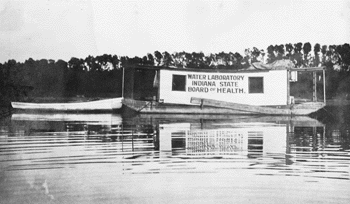A supply of pure water was one of the crucial elements for Indiana's earliest settlers. Often that supply was a pure spring or stream, or--if necessary--a well had to be dug.
As towns grew, water had to be provided and regulated. For example, in 1814, Jeffersonville, Indiana trustees passed the following ordinance to protect the town's public wells:
if any person or persons, after the date here of shall let the Bucket go down the well without supporting it by the handle or windlass or shall wrench [rinse] clothes at the well, or water horses with the buckets, he or she so offending shall on conviction thereof be fined fifty cents with costs for each offense (BROADSIDES: Indiana, The Early Years, Resource Guide [Indianapolis: Indiana Historical Bureau, 1987], p. 226).
Throughout the nineteenth century, the population of Indiana grew--and so did its industries. City and town officials found it more and more difficult to provide clean water and to deal with accumulating waste and garbage. Physicians and scientists were also beginning to understand diseases and connect them with sanitary conditions.
The Indiana State Board of Health under Dr. John N. Hurty emphasized testing of water supplies throughout the state. The board's laboratory was finally authorized by the General Assembly in 1905; it was opened in 1906 (Rice, 179, 180). The board also educated the public and officials about the need for controlling water pollution.
In its Annual Report for 1906, the board reported on the public water supply in the first annual report of its laboratory of hygiene:
The water supply, furnishing as it does water for drinking and domestic purposes, becomes an important factor in determining the health of a community. Indeed it is the most important of all the agents which administer to healthful life. Certain diseases are largely water borne, particularly diseases of the intestinal tract, such as cholera and typhoid fever, and the quality of water supplied to perhaps 90 per cent. of a town's population, is of first importance. This is realized more and more and the consumers today refuse to drink water that a few years ago was used without the slightest fear. . . . Water supplies should be constantly subjected to rigid inspection.
In 1911, the State Board of Health undertook a major survey of the part of the Ohio River that borders Indiana. Scientists traveled the Ohio River in a houseboat outfitted with testing equipment.
The principal object of the survey was to ascertain the suitability of the river as a source of domestic water supply and . . . to determine to what extent Indiana cities and manufacturing concerns are responsible for the pollution of the water (Annual Report, 1911, p. 335).
A major conclusion of the 1911 survey was
that, in its raw state, the river water is contaminated and unfit for drinking purposes at any point along the survey. . . . river water should not be used, as is now the case at several cities, without purification. It can only be made safe by filtration and chemical treatment (ISBH, Annual Report, 1911, pp. 400-1).
In 1913, the State Board of Health was authorized by the General Assembly to enforce pure water supplies in cities or towns (Indiana Laws, 1913, pp. 63-64).

The houseboat used in the Indiana State Board of Health Ohio River survey in 1911 (Jay Allen Craven, "A Sanitary Survey of the Ohio River Bordering Indiana" [Thesis submitted to the faculty of Purdue University for degree of civil engineer, June 1912], frontispiece).
